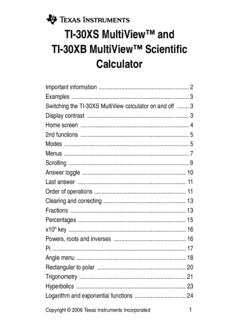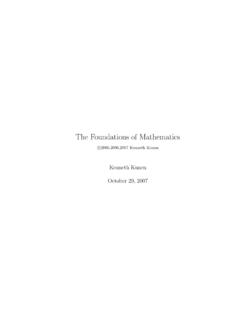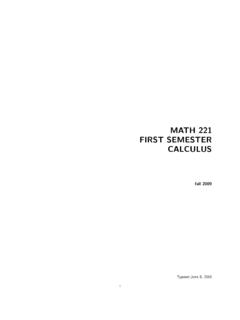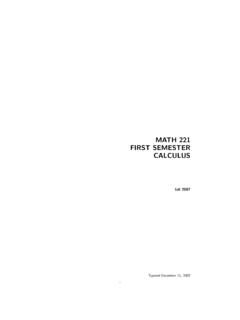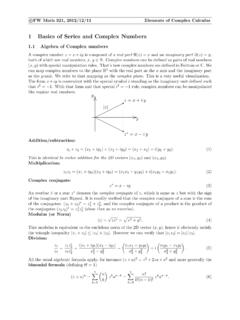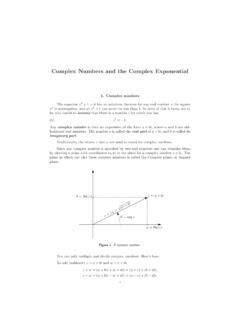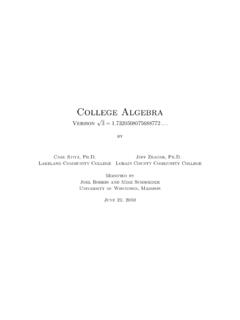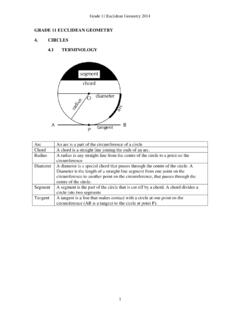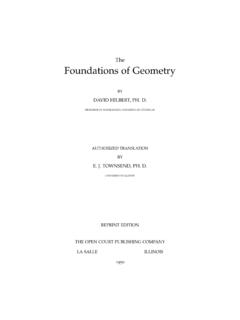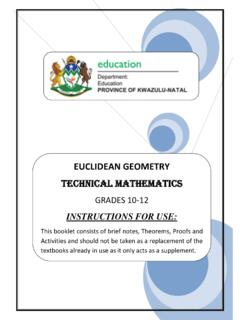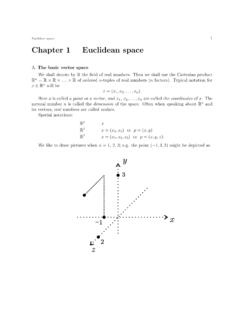Transcription of Coordinate Geometry - University of Wisconsin–Madison
1 Coordinate GeometryJWRT uesday September 6, 2005 Contents1 Introduction32 Some Every Angle is a Right Angle!?.. Every Triangle is Isosceles!?.. Every Triangle is Isosceles!? -II..73 Affine Lines.. Affine Transformations.. Directed Distance.. Points and Vectors.. Area.. Parallelograms.. Menelaus and Ceva.. The Medians and the Centroid.. 264 euclidean Orthogonal Matrices.. euclidean Transformations.. Congruence.. Similarity Transformations.. Rotations.. Review.. Angles.
2 Addition of Angles.. 395 More euclidean Circles.. The Circumcircle and the Circumcenter.. The Altitudes and the Orthocenter.. Angle Bisectors.. The Incircle and the Incenter.. The Euler Line.. The Nine Point Circle.. A Coordinate Proof.. Simson s Theorem.. The Butterfly.. Morley s Theorem.. Bramagupta and Heron.. Napoleon s Theorem.. The Fermat Point.. 546 Projective Homogeneous coordinates .. Projective Transformations.. Desargues and Pappus.. Duality.
3 The Projective Line.. Cross Ratio.. A Geometric Computer.. 677 Inversive The complex projective line.. Feuerbach s theorem.. 698 Klein s view of The elliptic plane.. The hyperbolic plane.. Special relativity.. 70A Matrix Notation71B Determinants732C Sets and Transformations751 IntroductionThese are notes to Math 461, a course in plane Geometry I sometimes teachat the University of Wisconsin. Students who take this course have com-pleted the calculus sequence and have thus seen a certain amount of analyticgeometry.
4 Many have taken (or take concurrently) the first course in linearalgebra. To make the course accessible to those not familiar with linear al-gebra, there are three appendices explaining matrix notation, determinants,and the language of sets and object is to explain that classical plane Geometry is really a subsetof algebra, every theorem in plane Geometry can be formulated as atheorem which says that the solutions of one system of polynomial equationssatisfy another system of polynomial equations. The upside of this is thatthe criteria for the correctness of proofs become clearer and less reliant downside is evident: algebra, especially complicated but elementaryalgebra, is not nearly so beautiful and compelling as Geometry .
5 Even theweakest students can appreciate geometric arguments and prove beautifultheorems on their own. For this reason the course also includes syntheticarguments as well. I have not reproduced these here but instead refer tothe excellent texts of Isaacs [4] and Coxeter & Greitzer [3] as needed. It ismy hope that the course as a whole conveys the fact that the foundationsof Geometry can be based on algebra, but that it is not always desirable toreplace traditional (synthetic) forms of argument by algebraic following quote of a quote which I got from page 31 of [3] should serveas a following anecdote was related by Bell [1] page Princess Elisabeth had successfully attacked a problem inelementary Geometry using coordinates .
6 As Bell states it, Theproblem is a fine specimen of the sort that arenotadapted tothe crude brute force of elementary Cartesian Geometry . Herteacher Ren e Descartes (who invented the Coordinate method)said that he would not undertake to carry out her a month. 3 The reduction of Geometry to algebra requires the notion of a transfor-mation group. The transformation group supplies two essential it is used to define the notion of equivalence in the Geometry in example, in euclidean Geometry , two triangles are congruent iff there isdistance preserving transformation carrying one to the other and they aresimilar iff there is a similarity transformation carrying one to the other.
7 Sec-ondly, in each kind of Geometry there arenormal form theoremswhich can beused to simplify Coordinate proofs. For example, in affine Geometry every tri-angle is equivalent to the triangle whose vertices areA0= (0,0),B0= (1,0),C0= (0,1) (see ) and in euclidean Geometry every triangle iscongruent to the triangle whose vertices are of formA= (a,0),B= (b,0),C= (0,c) (see ).This semester the official text is [3]. In past semesters I have used [4] andmany of the exercises and some of the proofs in these notes have been takenfrom that Some FallaciesPictures sometimes lead to erroneous reasoning, especially if they are notcarefully drawn.
8 The three examples in this chapter illustrate this. I gotthem from [6]. See if you can find the mistakes. Usually the mistake is akind of sign error resulting from the fact that some point is drawn on thewrong side of some Every Angle is a Right Angle!?RPOEDCBAQF igure 1:Every Angle is a Right Angle!?LetABCDbe a square andEbe a point withBC=BE. We willshow that ABEis a right angle. TakeRto be the midpoint ofDE,Pto be the midpoint ofDC,Qto be the midpoint ofAB, andOto be thepoint where the linesPQand the perpendicular bisector ofDEintersect.
9 (See ) The trianglesAQOandBQOare congruent sinceOQisthe perpendicular bisector ofAB; it follows thatAO=BO. The trianglesDROandEROare congruent sinceROis the perpendicular bisector ofDE; it follows thatDO=EO. NowDA=BEasABCDis a squareandEis a point withBC=BE. Hence the trianglesOADandOBEare congruent because the corresponding sides are equal. It follows that ABE= OBE ABO= OAD BAO= Every Triangle is Isosceles!?QRDOCBAF igure 2:An Isosceles Triangle!?LetABCbe a triangle; we will prove thatAB=AC. LetObe the pointwhere the perpendicular bisector ofBCand the angle bisector atAintersect,Dbe the midpoint ofBC, andRandQbe the feet of the perpendicularsfromOtoABandACrespectively (see ) The right trianglesODBandODCare congruent sinceOD=ODandDB=DC.
10 HenceOB=OC. Also the right trianglesAORandAOQare congruent since RAO= QAO(AOis the angle bisector) and AOR= AOQ(theangles of a triangle sum to 180 degrees) andAOis a common side. HenceOR=OQ. The right trianglesBORandCOQare congruent since we haveprovedOB=OCandOR=OQ. HenceRB=QC. NowAR=AQ(asAORandAOQare congruent) andRB=QC(asBORandCOQarecongruent) soAB=AR+RB=AQ+QC=ACas Every Triangle is Isosceles!? -II HHHHHHHHHHHHHHHDDDDDDDDBXCAF igure 3:AXbisects BACIn a triangleABC, letXbe the point at which the angle bisector of theangle atAmeets the segmentBC. By we haveXBAB=XCAC.
